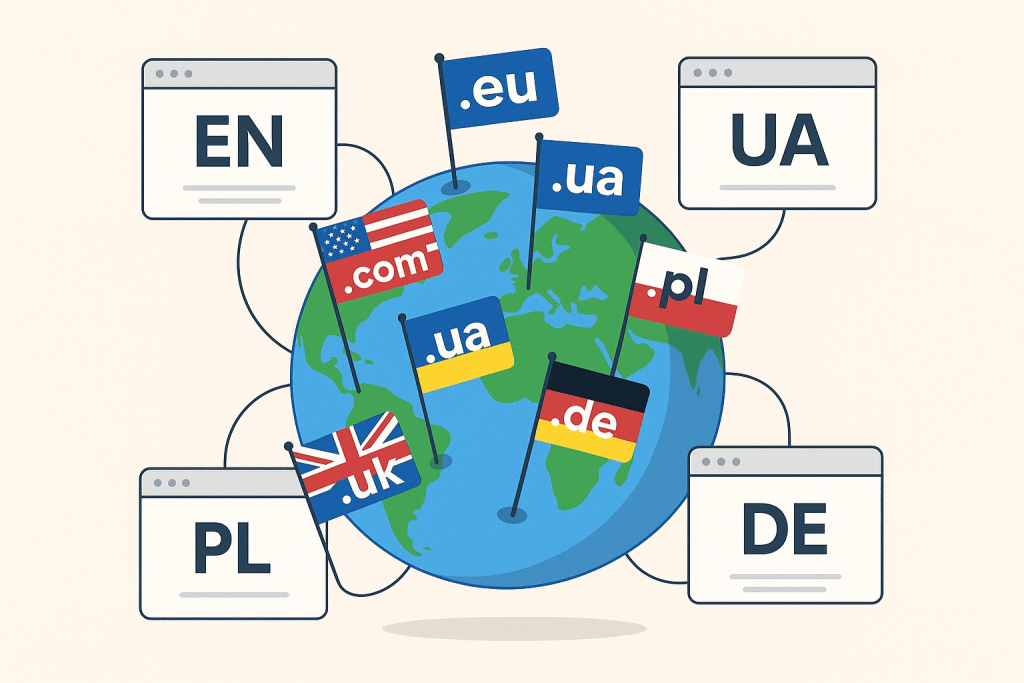
Launching a multilingual website is a key step for any business expanding into international markets. But along with translating content and adapting the interface, an important question arises: how do you choose the right domain name for different language versions without harming your SEO?
In this article, we’ll review the main approaches to domains for multilingual websites, discuss their pros and cons, and provide practical tips on working with .ua, .com, .eu domains and subdomains.
Why Choosing the Right Domain Is Critical for SEO
Search engines take into account a site’s regional relevance, the language of the content, and how well it meets user expectations. Poor domain structure or disorganized use of subdomains and folders can lead to:
- Traffic cannibalization between versions
- Indexing of the wrong language version for a given region
- Low visibility in local search results
To avoid these issues, it’s important to define a clear localization domain strategy during the website planning stage.
Three Main Approaches to Site Localization
1. Separate Top-Level Domains (ccTLDs) for Each Country
Example:
- example.ua — for Ukraine
- example.pl — for Poland
- example.de — for Germany
Advantages:
- Maximum alignment with local expectations
- Better ranking in local Google versions (e.g., google.com.ua)
Disadvantages:
- Each domain requires separate SEO and promotion
- Higher costs for hosting, marketing, and support
When to use it:
This approach works best for large businesses or brands with offices in multiple countries. For example, when using .ua domains for the Ukrainian market, it’s essential to meet local registration requirements and use a trusted registrar like RX-NAME.
2. Using Subdomains for Each Language Version
Example:
- ua.example.com
- pl.example.com
- en.example.com
Advantages:
- You can keep a single primary domain
- Each language version is easy to identify
Disadvantages:
- Each subdomain needs individual SEO configuration
- Search engines may treat subdomains as separate websites
When to use it:
This is a good option for businesses that want centralized content management while maintaining clear language or regional identity.
3. Using Subdirectories for Language Versions
Example:
- example.com/ua/
- example.com/pl/
- example.com/en/
Advantages:
- All pages stay under one domain authority
- The SEO weight of the main domain boosts all versions
Disadvantages:
- Harder to separate traffic metrics per language
- Requires thoughtful site structure and correct hreflang implementation
When to use it:
This is the most suitable option for small and mid-sized companies with moderate traffic levels.
Which Domains Work Best: .ua, .com or .eu?
- .ua — Perfect for the Ukrainian market and boosts user trust. However, it requires a registered trademark to get a second-level domain (like company.ua). As an alternative, you can use public zones like .com.ua.
- .com — A universal choice for international businesses. It suits websites targeting global or multi-country audiences.
- .eu — Ideal for companies operating within the European Union. It reflects regional identity, though it doesn’t always indicate the site’s language.
Choose your domain zone based on your target audience and geographic market. If your business operates across several regions, consider combining zones with subdomains or subdirectories for flexibility.
Practical SEO Tips for Multilingual Websites
- Use the hreflang tag — It helps search engines understand which version of a page is meant for which language or region. This is crucial to avoid duplicate content issues.
- One language — one URL. Don’t mix multilingual content on the same page.
- Avoid automatic translation as the main localization method. Machine-translated content tends to be low quality and harms your ranking.
- Optimize each language version separately. This includes meta tags, titles, descriptions, and keywords tailored for each audience.
- Use a separate sitemap.xml for each language version or one unified file with hreflang attributes.
- Ensure speed and security. For multilingual websites, it’s recommended to use a reliable server or VPS to provide stable performance across regions, and a valid SSL certificate for each subdomain or language version.
Conclusion
Choosing the right domain and URL structure for a multilingual site is not just a technical decision — it’s a strategic move that affects your visibility in search engines, user trust, and conversion rates. When choosing between ccTLDs, subdomains, or subdirectories, consider your project’s size, target markets, and available resources.
Regardless of your approach, the key is to maintain a clear structure, deliver high-quality localized content, and ensure strong technical SEO. To help you secure the best domain for every region, use the domain registration service from RX-NAME.

Leave a Reply